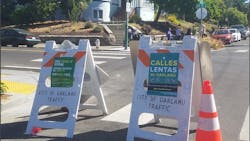Fewer cars, slower streets: The potential of the Oakland Slow Streets Program to transform communities
The city of Oakland, Calif., in April 2020 announced it would close 10 percent of all city streets to through traffic in response to the rising COVID-19 pandemic to make more space for bicycle and pedestrian uses and transform streets into safer and more inviting spaces for people to spend time outside.
New Mineta Transportation Institute (MTI) research, “Analyzing the Use and Impacts of Oakland Slow Street and Potential Scalability Beyond COVID-19,” examines how the 2020-2022 Oakland Slow Streets were used, their impacts on local transportation and the community and the potential to scale this or similar projects beyond the pandemic.
To examine how the Oakland Slow Streets were being used and what impacts they were having on vehicle speeds, researchers collected three types of data: real-time traffic speeds, on-site passerby counts of vehicles and pedestrians and additional on-site observations of local conditions.
The data collected suggest conflicting findings about the success of slow streets from one neighborhood to another. Specifically:
- They do not constitute clear evidence that a Slow Streets designation itself reliably yields reduced through traffic, slower traffic speeds or increased pedestrian and bicycle uses. Some slow streets exhibited desired outcomes while others did not.
- However, certain slow streets did have more bicycle/pedestrian use than their nearby comparison streets, and, in at least one case, it can be said that the slow street was clearly embraced by the local community and used regularly.
“The performance of Oakland’s Slow Streets program was uneven; their use varied from neighborhood to neighborhood, seemingly based as much as anything on the particularities of local needs, norms and preexisting traffic patterns, but even where they were not locally embraced, our findings do not suggest they had negative impacts in terms of street safety or area traffic flow,” explain the study’s authors.
The study’s findings help identify local conditions that may make a street more likely to yield the intended bicycle or pedestrian uses as a slow street. All neighborhoods deserve safer streets and greater bicycle and pedestrian opportunities. Future slow street programs should prioritize community outreach to ensure that even areas not predisposed to embrace or make use of slow street treatments initially can work with planners to emphasize local priorities and opportunities and empower everyone to be able to use streets effectively and safely.
The report is available on MTI’s website.

